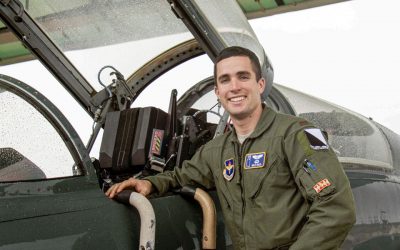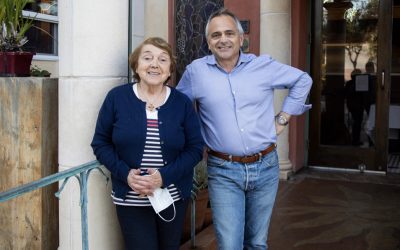As nights grow longer and the temperatures climb, a most-frequently heard conversation around SLO County goes like this: “You going to the Fair this year?” “Sure! Who’s playing?”
First held 1946, the California Mid-State Fair is preparing for its 75th anniversary next year, and the entertainment creates a lot of prefair buzz. But it didn’t always. For the first two decades, fair-goers looked forward to livestock and rodeo competitions, blue-ribbon baked goods, cotton candy and corn dogs, scary rides and big stuffed animals. We came to the Fair in droves to find a reprieve from the workaday world in the festive carnival atmosphere; to romp and rollick in the endless summer nights; to celebrate life with old and new friends. And we still do.
But in 1969, Maynard Potter (then CEO of the SLO County Fair) brought Buck Owens to the main stage, beginning a tradition of musical acts that now include every genre (except classical) and appeal to every taste, every age group. Look no further than this year’s lineup for proof: Blake Shelton, Miranda Lambert, the Zac Brown Band, and Old Dominion offer country fans the best in the business; Billy Idol is a revered English rocker; Smokey Robinson is a Motown legend; Pat Benatar, Neal Giraldo, and Melissa Etheridge are American rock hit-makers; Cardi B is a young hip-hop rapper; and old time rockers Lynyrd Skynyrd balance out the popular boy band Why Don’t We.
A great mix, right? So who decides who’s playing, and how do “they” make those decisions? Current Fair CEO, Mike Bradley and his team make up the “they.” This includes Jam Productions of Chicago, Live Nation, Ron Pateras (the Fair’s entertainment buyer) and Tom Keffury (who heads the Fair’s marketing and sponsorship efforts). Bradley says they look at the following six elements: Marketplace acceptance (country is still the most popular genre and therefore the more heavily represented in the lineup); what acts will attract those looking for a more traditional sound; what acts will attract those looking for cutting edge music; do we have enough diversity; will this lineup bring maximum customer satisfaction, and return on investment (will we make money?).
Bradley, a former Agriculture Science and Education student at Cal Poly who says he practically grew up on fairgrounds in California and the MidWest, began his professional life working summers at fairs, including for our own Maynard Potter in the 1970s. He has worked for the California State Fair in Sacramento, the California Farm Bureau Federation, and was Executive Director of the Arizona National Livestock Show in Phoenix. He’s the recipient of numerous awards from the Western Fairs Association, The California Foundation for Agriculture in the Classroom, and the American Livestock Industry. He’s even traveled to Hong Kong and mainland China to develop training programs for exposition professionals in Asia. He’s been CEO of our Fair since 2016. And he likens our 12-day Fair to putting on the world’s biggest wedding party.
“It takes a year to plan,” he explained. “And [like weddings] you have all these moving parts—vendors, food, music, families, personalities, crowd control …”
If you were among the lucky 30,000 people who saw Garth Brooks two years ago, you’ll probably recall it as one of the best musical events of your lifetime. Bradley says it was that, and a huge logistical success in crowd control. Tickets went on sale online and sold out in 30 seconds. So Brooks announced he would do a second show, which also sold out in seconds. The stadium holds almost 15,000 so Bradley was tasked with making sure that the first crowd exited while the second crowd entered smoothly and safely. Brooks began at 8 pm and it would be 3:30 a.m. before he took his final bow.
“Everyone was happy. Brooks was incredible. It was a perfect night,” says Bradley.
A little less than perfect was the year that American heavy metal rockers Motley Crue played the main stage. Delayed flights caused the group to be three hours late for their show start. The audience waited patiently and at 11:30 pm, they were rewarded for their patience.
And then there was the year when Aerosmith’s Joe Perry was appearing with Alice Cooper and Johnny Depp (the Hollywood Vampires), a wildly popular event. Perry had a sudden and unexpected medical setback mere days before the show, nearly causing Fair officials their own “setback.” But Perry pulled through and played, according to Bradley, “tremendously” that night. Aerosmith itself also played the Fair in 2007 in a sellout show.
In the 1980s, the then-exclusively country lineup at the Fair diversified to include rock and jazz. So now, in addition to country superstars Kenny Rogers, Dolly Parton, George Strait, and Alan Jackson, fairgoers were treated to such rock legends as Paul Simon, Kenny Loggins, Journey, Stix, Lionel Ritchie, and Bob Dylan. Jazz musician David Benoit played the stadium one year, starting an annual tradition where large pre-paid tables and catered dinners make the evening slightly more “civilized.” This year’s Rhythm and Brews event features the one-and-only Billy Idol; while the Music & Wine evening will showcase the legendary talents of Motown singer-songwriter, Smokey Robinson.
Music may now be the number one draw, but our Fair is famous for so much more. Bradley points to a number of events exclusive to ours that make it “America’s Favorite Fair.” It’s the only fair that features a country rodeo made up of local ranchers and farmers who compete on the skills they use every day, versus professionals who ride the rodeo circuit. It’s also the only window the public has to the agricultural way of life. At the Fair, you can get advice on how to grow roses or tomatoes, how to prune an apple tree, even milk a cow. Wine is now a huge element of our Fair, showcasing our local vineyards and offering daily competitions and wine-tasting. With exhibits ranging from Tractor Restoration to Photography; with commercial vendors selling everything from vegomatics to the perfect chamois; with horse shows, home shows, and the best fair food (stuff on a stick!) in the state, it’s no wonder this year’s theme is “Let’s Have S’More Fun!”
Not to put a damper on that fun, Bradley says that more emphasis on safety and security—for fair-goers and artists alike—has been a recent priority. We may have to tolerate a little more scrutiny upon entering the fair, but the reward of a happy day that’s safe and trouble-free is well worth it.
The future of the Fair and its world-famous entertainment is in good hands. “Everyone is on our list,” says Bradley. Besides popularity, fair officials have to find acts that want to play here (some, says Bradley, won’t play outside venues, for example). Some are simply not in the country; many tour during the summers. Toward that end, he and his team work hard to be on the front edge of entertainment each year, to diversify even more, and to work on facility improvements. Things like better seating, better sound, increased video screen size (this year it’s double what it was last year), and an improved, more spectacular lighting system. As technology improves, so does the quality of the experience.
It’s come a long way from its humble country beginnings back in 1946 when the first fair opened its doors. Then called the San Luis Obispo County Fair, it was located across the street from its current location, in what is now the parking lot, and was held in two large tents. Twenty thousand people enjoyed the three-day event for an admission price of $3.60. Today, more than 425,000 guests will stream through its gates. They’ll find the same simple joys that have always drawn them. No other place in the world has the unique sights, sounds, and smells of a bustling country fair. And no matter who you are—male or female, young or old (or somewhere in between), country fan, devoted rocker, jazz or hip hop lover—the main stage will ring with the sounds you love to hear.
“Our biggest challenge is predicting the next great artists to invite,” said Bradley. “And our biggest reward is getting that right.”
On Pacific Time.
Always open.
Email or call
805-466-2585
Loving Life on the
Central Coast, California
On Pacific time.
Always open.
Email or call
805-466-2585




